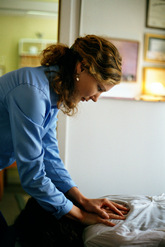| Sylvia Skefich, D.C. Email: skefich@att.net | Phone: 831-475-1995 |
Crani0-Sacral Physio-Therapy
Dr. Skefich working
on

|
SOT is a chiropractic technique which was influenced from Osteopathic tradition. Major DeJarnette developed SOT after obtaining degrees in Osteopathy and Chiropractic. He was a patient and student of Willliam Sutherland, the founder and developer of cranio-sacral work. SOT categorizes the type and severity of stress patterns in a patient. The body is amazing. Each person will have certain areas in them that, unless released from their tension, will not allow other areas to soften. The areas will vary from person to person, and are frequently not the location of the pain. Here is an analogy: let’s say you have a pebble in your shoe. As long as you do not step down hard, there is no pain. So you limp along, and eventually your leg and hip get sore from the limping. All the massage or adjusting in the world will not help your sore leg (for long) until the pebble is removed. SOT helps identify where that pebble is and how to gently and effectively remove it. Additionally, each body will have parts that have become unconscious and need re-integration into the whole again. The organs, glands, muscles, joints and meninges are all accounted for by looking at the signs the body shows. Within SOT, stress in the body is seen in gradations of severity. There are three "categories" of severity, and severity is not at all determined by pain level but by the signs the body shows and that the doctor assesses. Knowing what category a person is in gives a better indication to the doctor of how long it will take to resolve a problem. In Category I, the body knows what neutral is, and will try to right itself once the stress has gone. To be able to respond to stress in one's lide is a good thing, but it is also good to know when to relax. In Category I, a person can relax. Category I is a flexible and adaptable place to be in, even though there may be temporary, even severe pain. Category II is a state of more advanced stress. This could come suddenly from a fall or a hit, or even a strong mental shock, but more often than not, is simply a result of chronic stress. Recall that stress winds you up, like a person on the starting line (one hip forward, the opposite shoulder forward). This is frequently what the chiropractor will check when they note a high shoulder or a "short" leg. It is simply held muscle tension distorting the body. In Category II, the stress wind-up has become a habit. The body does not know quite how to unwind or may not even know that there is such a thing as being unwound anymore. This person will need expert assistance to get unwound quickly. In Category II, the wind-up is stuck in place. This is an expression of the body’s wisdom to conserve energy. If a person is going to be wound-up all the time, why waste nerve and muscle energy in being tense? The body has begun to lock things down into the mal-position of stress wind-up. And to have a tense body can lead to a tense mind and stressed out response to your environment. Advanced Category II has multiple layers of tension like an onion. The body patches on various tension patterns to try to hold things together including the pattern of compression as discussed in Category III. What is Category III? Well, let’s look back to Categories I and II; If you twist a rope (or a spinal cord), it will shorten. A shortened spinal cord is a spinal cord under traction. Traction is bad for nerves. It changes the firing pattern of nerve impulses and then the brain can no longer interface with the outside world in a simple way due to nerve interference. It is like static in the message system. The body will do anything it can to reduce traction on the brain and spinal cord in order to reduce nerve interference. First, it will try to initiate relaxation by becoming uncomfortable and making a person want to rest, stretch, or exercise (as in Category I). But if the brain is dealing with continual messages of stress due to lifestyle choices or mental attitudes or body distortion, how can the body relax? It can’t. So over time the vertical muscles compress and shorten; If the body is successful in shortening down the bony spine, then it will be successful in giving some slack to the spinal cord inside, even if this results in compressed, degenerated or herniated discs over time. Herniated discs almost always happen in the lumbar and cervical spine (low back and neck). This is because the vertical muscles of the spine exist here, capable of compressing the discs. Discs are like sponges, in a sense. They have no vessels to bring blood to the living cells of the cartilege. Cellular nutrients and cellular waste must be transported instead by "imbibition," which is like pulsing a dirty sponge between your hands in a bucket of clean water. The old fluids get pulsed out, and the clean fluids get pulsed into the disc. This compression-decompression should happen naturally with movements and breath. But when there is chronic wind-up with the resultant compression compensation of the spinal muscles, there is decreased imbibition and fluid exchange. The discs get sick over years of this compression. "DJD" or degenerative joint disease is evidenced in the average asymptomatic person by age 35 and is not a natural result of age as some doctors believe. It is instead a response of the body to a less than optimal situation. The body has prioritized the spinal cord and brain above the discs in a person with compression. The body is eminently wise. It chooses its priorities for survival flawlessly. The body does nothing by accident or mistake. Disease is the body's responsse to a less than optimal situation in Dr. Skefich’s opinion. SOT will also diagnose and treat organ dysfunction of a mechanical nature. This is not to say that Dr. Skefich will treat diseases. However, all organs are held in place by ligaments, and are made of tissue or smooth muscle. Dysfunctions in this realm can be treated using the diagnosis protocol and visceral manipulation of SOT and cranio-sacral technique to enhance nerve, blood and lymph function, and thus increase vitality. For more information on this subject, go to www.SORSI.com and www.SORSI.com/research.htm.
|
Doctor of Chiropractic, Sylvia Skefich � Santa Cruz, California 831-475-1995 |

